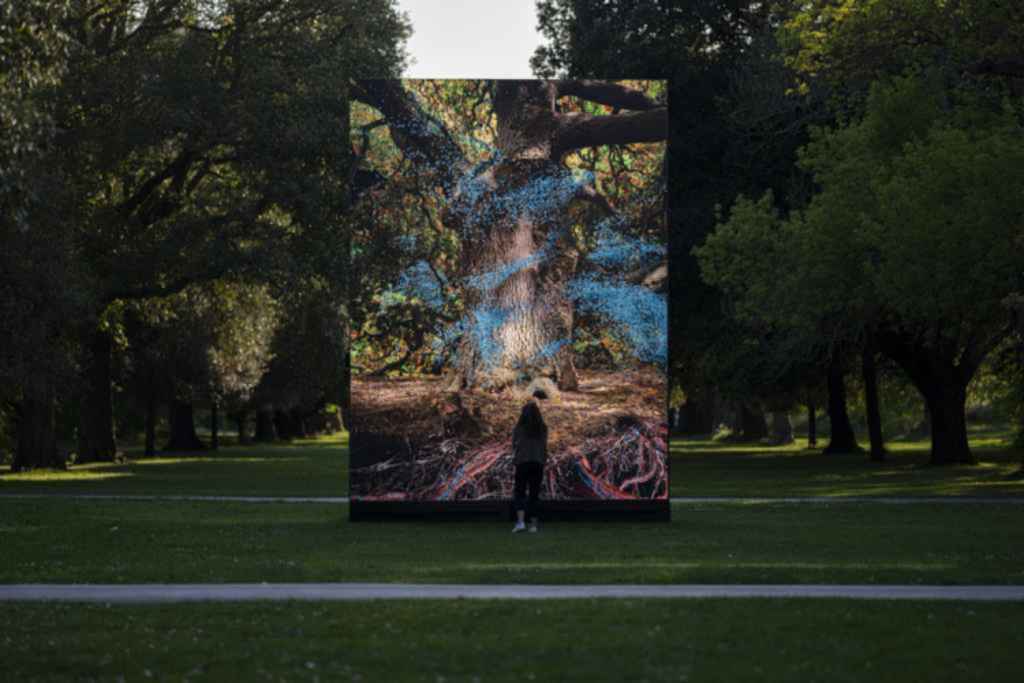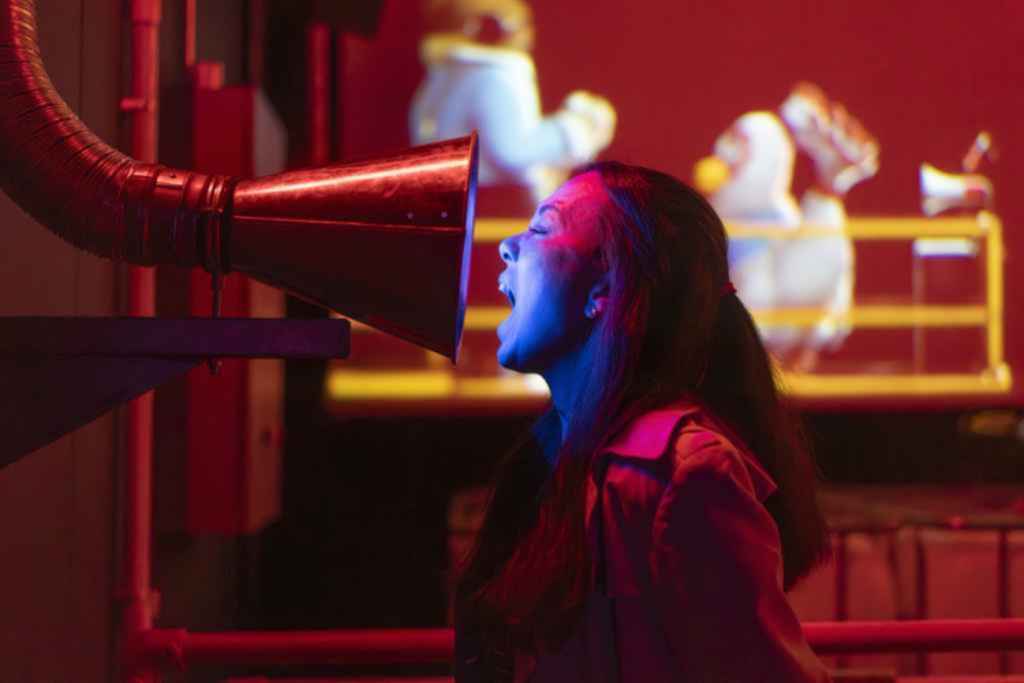Art collective Marshmallow Laser Feast is blending art with immersive experiences, XR and film to bring meaningful stories to life. Paul Milligan speaks to its co-founder Robin McNicholas.
Marshmallow Laser Feast is an experiential art collective that has been working in the immersive space for more than a decade. Robin McNicholas, its co-founder anddirector, describes its work as “cherry picking from live shows,AV shows, art, immersive art,the museum space, and culturalspaces.”
Marshmallow LaserFeast (MLF) exhibits work andcollaborates with curators globally to present artworks centred around our relationship to the natural world. MLF’s body of touring work involves multi-sensory VR, screen-based experiential work, light sculptures, kinetic light work, and the immersive narrative space. Are we seeing art and technology become closer as this century progresses? “What we’ve found working with curators anddifferent cultural entities is an increase in commissions that are warm to digital culture and that’sbeen a real bonus for us.” We live in an age where our mobile phones (effectively pocket-sized PCs) are never out of our hands.
Are artists just reflecting the times by utilising technology in art projects, or does the use of VR or XR give them new mediums to explore?“It’s about standing out in thenoise of all the media saturationto some extent. There are opportunities for artists working with technology to actually create something new and unexpected. The digital literacy of audiences has meant that they’re warmer to it, and more willing to interact with it. Digital culture has propagated globally, and there’s an important role for artists to play within that,” says McNicholas.
MLF was created to fuse art and technology, does it do that by having people skilled in art or technology, or in both? “We have a team of multi-disciplinary, multi-skilled people that are tech-savvy and keep a keen eye on the scene. Part of the way our collective operates is that some of our lifeblood comes from when we invite experts in. These experts can be scientists, mechatronics experts, poets and writers.
As a collaborative entity, unlike individual artists who may paint an oil painting, we depend on one another and therefore have to, as part of our working culture, share new ideas, share new innovations in the tech world, but also think critically about tech. We’re very mindful of the zeitgeist technologies out there, and we are willing to lean in. The use of VR is well established now, everyone’s competing for people’s attention and it’s a real position of privilege to have an audience member fully commit, put a headset on and say here’s my undivided attention, show mewhat you’ve got,” explains McNicholas.

MLF has been blending art with immersive experiences, XR and film. Can these technologies helpbring relevancy to institutionssometimes hundreds of years old, who have always done things in a traditional way? “We’ve found a willingness from cultural entities across the globe to bring immersive art and tech or the kind of organisation that MLF is, into their spaces. It’s very much a collaborative effort becausethese are really well established institutions. Tech is moving at a rapid rate, so staying relevant is a real challenge for everybody.”
As an example, MLF presented work at the Saatchi Gallery in 2018 for a project called Relive in an Ocean of Air. “That institution took a risk in bringing a VR experience to their audiences, but they attracted new audiences because of the tech, and that is a gateway in, as a way of inviting teens and their parents into the same space. It’s a very positive story for an institution trying to reach new audiences.”
MLF has produced a number of immersive experiences, why does McNicholas think there is such a craving for these at this moment in time? “It’s an indicator of the cultural importance of being together. Home cinema has been a reason for declining cinema tickets, but the need for being inspaces together, especially in a media saturated environment, plays a big part in it. The spectacle of these large spaces and the increase in impressive spaces, such as Atelier des Lumières, Lightroom, and Factory International, means there’s a network of immersive cultural spaces which have the technical expertise to host this work. Another factor is the(falling) price point of projectiontechnologies, and the skill of media servers in how you blend projectors, it’s so much easier than when we first started out.”
The Of The Oak project which was on display from May-Sept this year at Kew Gardens in London was an immersive installation tocelebrate the oak tree as a networkof relationships through a huge interactive video screen and multi-channel audio. Of The Oak included photogrammetry (stitching together thousands of images) and LiDAR scanning (mapping the tree’s form with laser pulses). When you think of a subject matter so steeped in nature as this one, you might not automatically jump to using technology, so why did MLF decide on these elements for this project?
“It was a brilliant opportunity to collaborate with the arborists from Kew Gardens who were able to provide a wealth of information, data, knowledge, and a new and very passionate perspective. The moving image was the only way we could create a tangent and make sense of all of this information and condense it. On the reverse side of the monolith is one of the most emotionally impactful moments where you see a list of species that depend on this one tree. The aim is really to bring analogue elements and sonic elements [there were a series of poems, meditations distributed across the botanical garden using hidden, embedded speakers fitted within the grass] that help bed in the technology.”

Another MLF project in 2025 was You:Matter, an immersive exhibition designed to explorethe universe and our relationship to it from the Big Bang to now, commissioned by the NationalScience and Media Museum for Bradford 2025 UK City of Culture. How do you approach a subject as complex and dense as the Big Bang? It was especially challenging admits McNicholas. “What we ended up with was a series of multimodal experiential beats. Moments where people would enter a space where there’s a large projection and spatial sound. But there were physical interfaces as well as sculptural elements and sonic elements. We talked about the core elements of what makes a human being and used physical interfaces such as adapted selfie rings for younger audiences.”
MLF created a series of interactives for You:Matter including We Live In An Ocean Of Air, which uses breath sensors and real-time projection to allow visitors to visualise their own exhalation as it flows into a Sequoia tree, to explore the exchange of gases between humans and plants. For A Breathing Planet, a circular screen uses satellite data to show the day/night cycle of carbon dioxide, thevideo pulses to portray the feel of a living, breathing Earth. Head In The Clouds features two large cloud sculptures which invite visitors to put their head inside where a soft-spoken voice takes the visitors on a journey through the water cycle, from cloud to rain, from tea to sweat, from human to sky. The Sunlight Under My Skin installation asks visitors to placetheir hands under a beam of projected light to reveal the bloodvessels beneath their skin, and the radiance of the sun flowing within.
Like all successful immersive projects, the story has to play a central role alongside the technology, otherwise it risks being overshadowed by it and the message gets lost. Crafting a story is fundamental to MLF projects says McNicholas. “Technology can be used as a means of marketing; we are centred around focusing on the stories we’re telling with that technology. It’s part of the puzzle to attract audiences in. It’s then what do you say and how do you say it? What we’re passionate about is refining the craft of making these experiences meaningful, telling stories that are important to us."